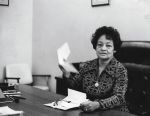When she accepted the position of associate editor of the magazine section little did she know that this would be the first of many doors she would open for women at the Pittsburgh Courier.
Hazel Garland joined the Courier staff in 1943 as the women and society writer for the city edition, allowing Toki S. Johnson to spend more time on the national side. But as the years passed Garland not only worked on the city side of the desk but began to take on more and more national assignments as well as entertainment, to the point where she was promoted to become the first female editor for the paper as she became the associate editor of the magazine section in the early 1950s. The exact year is not known.
 |
|
HAZEL GARLAND
|
Even though Johnson remained the principle women and society writer through the 1950s and ’60s Garland demonstrated much more diversity as she covered a larger array of events during the ’50s and ’60s to the point that new General Manager Carl Morris had no hesitation in naming her the Courier’s first female city editor in the early ’70s with the full support of new owner John Sengstacke. Even though her background was in society and entertainment she had a complete feel of the pulse of the Black community.
“I’ve always been proud of Black people and the many things we have accomplished despite the massive obstacles placed in our way,” Garland said. “I covered good news for years. But it was news none the less. It was what Black people felt was important to them. These are successful people who had the same obstacles placed in their way as others, but instead of complaining, or finding excuses they went out and did something about it. They didn’t allow racism and prejudice to hold them back; they fought the odds and won. But they continued to give back. Most of the society things I covered are generally not only to have a good time but to raise money to help others less fortunate Negroes go to college.”
Sengstacke had so much confidence in her work that he promoted her to editor-in-chief in 1975 which meant she had final say in all editorial matters containing to the paper.
“I have supreme confidence in Hazel (Garland), and believe that she will continue to do a great job as editor-in-chief as she did as city editor,” Sengstacke said in announcing the promotion. “She has proven herself over the many years of dedication to the Courier and the Negro cause. She will be a guiding force in leading this paper to bigger and better things in the future.”
Garland said that she never really thought of titles, positions or anything else while rising through the Courier. “I just wanted to do the best job I could,” she said. “I just wanted to follow in the giant footsteps laid down before me by some of the greatest newspapermen in the history of journalism. I’ve always felt that Negroes deserve the best effort we can give them and this I’ve always done. Just like others motivated, helped and assisted me, I’ve tried to do the same with other, especially all the young people coming through the doors at the Courier. I want to give back all the vast knowledge shared with me, by some very, very great people.”
Even though she retired in 1977, because of her health, she continued to write her two columns Video Vignettes and the extremely popular Things To Talk About. He gave her the title of assistant to the publisher, where she served as a consultant to Sengstacke through the mid 1980s. She died in 1988, at the age of 75.
Frank Bolden, long time Courier writer and news editor stated “without her the Courier would have folded during that period when Sengstacke came in. Under her it became a better prepared product. She didn’t appreciate making mediocrity respectable. Hazel was one of two top women in journalism, the other being Ethel Payne of the Chicago Defender.”
There were other women in high profile positions with the Courier before her such as Jesse Vann, who took over the ownership of the Courier after her husband’s death in 1940, to serve as president and treasurer; and Daisy Lampkin who was the vice president for most of those years, but neither of these women despite their titles had much to do with the daily operations of the Courier, especially on the editorial side. And there were many major female contributors to the Courier such as Willa Mae Rice in religion, Evelyn Cunningham who reported news, entertainment and society news out of New York City, and Toki Johnson who was an extremely famous social writer, but Garland went where none of the others went. She was second to Magazine Section Editor George F. Brown for a number of years. Not only writing but was a key part of the layout and design of this before its time magazine. She helped decide what would go in it and how it would be illustrated, which is why Sengstacke had no hesitation in promoting her to the city editor and editor slots.
Garland devoted her life to the Courier and what it stood for. “I will always love the Courier, and the people who made it what it was and is,” she said. “We tell the stories. We tell the stories of the people. We told the stories of Colored people, we told the stories of Negroes, we told the stories of Black people and now we tell the stories of African-Americans. Does it really matter, sports, social, entertainment, or political. They are all our stories, and if we don’t tell it, who will?”